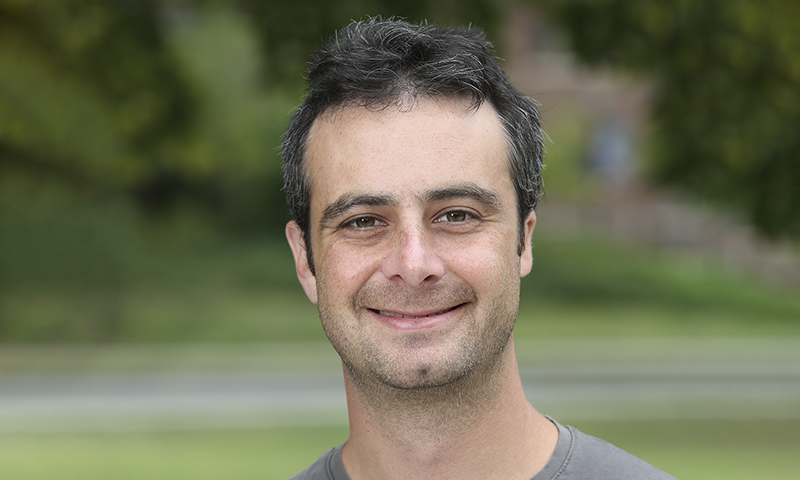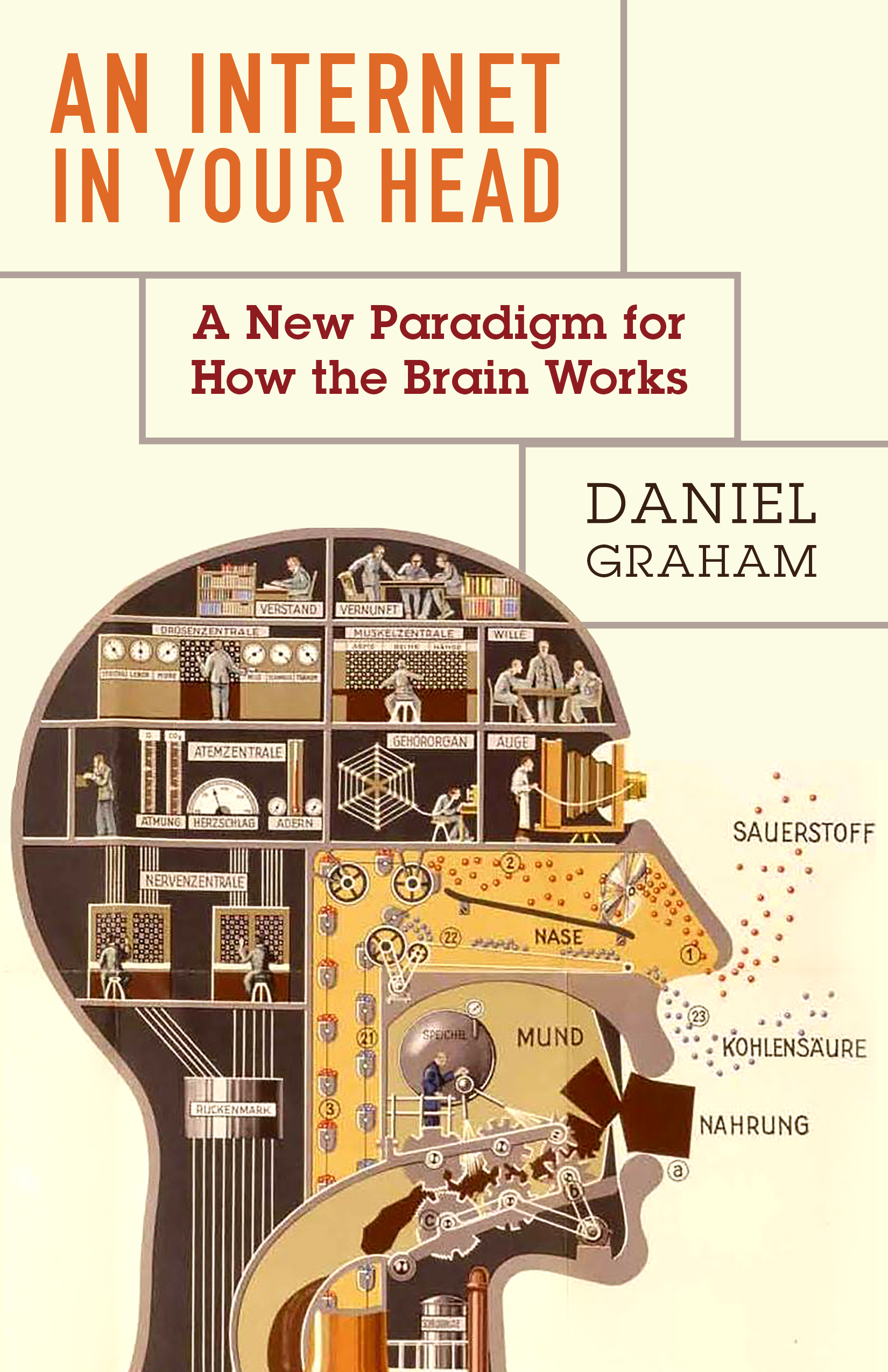
Daniel Graham

Daniel J GrahamProfessor of Psychological Science
Joined faculty in 2012
Ph.D., Cornell University (Psychology)
M.S., Cornell University (Physics)
B.A., Middlebury College (Physics)
Contact Information
Promotional materials should be sent to milella@hws.edu.Email: graham@hws.eduPhone (315) 781-4526Personal Homepage
Scholarly Interest
I am author of An Internet in Your Head: A New Paradigm for How the Brain Works published by Columbia University Press (2021). The book proposes that we can achieve a new and better understanding of how the human brain works if we compare its basic operation to that of the internet. I write a blog for Psychology Today on the same theme.
Research
I investigate human and mammal brains from a variety of perspectives. I use computational, behavioral, and theoretical approaches and focus especially on vision coding.
One ongoing strand of work focuses on natural, aesthetic, and artistic stimuli and their processing and creation.
In tandem, I collaborate with Prof. Yan Hao (HWS Mathematics) to investigate the fundamental principles of communication among neurons in mammal brains. In particular, my multiple strands of research focus on:
(1) network dynamics in cortex and at the whole-brain level
(2) principles of efficient visual system processing of natural scenes, artwork, and faces in the visual stream
(3) models and mechanisms in neuroaesthetics
Tying all of these strands together is the notion of efficiency: neural systems are shaped by evolutionary adaptation, which tends to produce solutions that are well matched to environmental demands. However, efficiency is not simply about using the smallest amount of resources; it also depends on handling and representing information in a way that is useful to the organism. Drawing on notions from information theory in physics, the encoding of environmental stimuli can be rigorously defined and implemented in physiological simulations and computer vision approaches.
Courses Taught
In-Person Courses
Psychology 100 Introduction to Psychology
Psychology 299 Sensation and Perception
Psychology 309 Topics in Sensation and Perception
Psychology 398 Advanced Theory and Design in Sensation and Perception
Psychology 498 Capstone Research in Sensation and Perception
Fully Remote Instruction, 2020-current
Psychology 299 Sensation and Perception (regular semester and J-term, Maymester/Summer)
Psychology 398 Advanced Theory and Design in Sensation and Perception
Psychology 498 Capstone Research in Sensation and Perception
Publications
**indicates H WS student co-author
Graham D.J. (2023) Nine insights from internet engineering that help us understand brain network communication. Frontiers in Computer Science 4:976801. doi: 10.3389/fcomp.2022.976801
Graham D. J., Avena-Koenigsberger, A., and Misic, B. 2020. Editorial: Network Communication in the Brain. Network Neuroscience 4 (4), 976-979.
Hao, Y. and Graham, D. J. 2020. Creative destruction: Sparse activity emerges on the mammal connectome under a simulated communication strategy with collisions and redundancy. Network Neuroscience 4(4) 1055-1071
Graham, D. J. 2020. The use of visual statistical features in empirical aesthetics. In: M. Nadal and O. Vartanian (Eds.), Oxford Handbook of Empirical Aesthetics, Oxford University Press, UK. DOI: 10.1093/oxfordhb/9780198824350.013.19
Graham, D . J . and Hao, Y. 2018. A selective diffusion model of brain network activity. Proceedings of the Conference on Cognitive Computational Neuroscience, 1195.
Graham , D . J ., 2017. Commentary: Building brains that communicate like machines. Behavioral and Brain Sciences e266, 37-38.
Pugach, C.** Leder, H. and Graham, D. J. 2017. How stable are human aesthetic preferences across the lifespan?. Frontiers in Human Neuroscience 11:289. doi: 10.3389/fnhum.2017.00289.
Graham, D. J., Schwarz, B., Chatterjee, A. and Leder, H. 2016. Preference for luminance histogram regularities in natural scenes Vision Research, 120, 11-21. Supplemental Data
Pugach, C.,** Daley, E.**, Leder, H. and Graham. D. J. 2014. Aesthetic stability in development. In: Proceedings of the International Association for Empirical Aesthetics Biennial Congress 2014, New York, NY. ISBN: 0-692-29396-5.
Graham, D. J. 2014. Routing in the brain. Frontiers in Computational Neuroscience 8:44.
Graham, D. J., Pallett, P. M., Meng, M. and Leder, H. 2014. Representation and aesthetics of the human face in portraiture. Art & Perception, 2(1-2), 75-98.
Graham, D. J. 2013. Integrating holism and reductionism in the science of art perception. Behavioral and Brain Sciences, 36(2), 145-146.
Graham, D. J., Stockinger, S. and Leder, H. 2013 An island of stability: art images and natural scenes—but not natural faces—show consistent aesthetic response in Alzheimer’s-related dementia. Frontiers in Psychology 4:107.
Graham, D. J. 2011. Visual Perception: Lightness in a High Dynamic Range World. Current Biology 21(22), R914-R916.
Graham, D. J. and Rockmore, D. N. 2011. The packet switching brain. Journal of Cognitive Neuroscience, 23 (2), 267-276.
Graham, D. J. and Meng, M. 2011. Artistic representations: clues to efficient coding in human vision. Visual Neuroscience 28, 371-379 [Special Issue on comparative, ecological and developmental aspects of visual system design and function]
Graham, D. J. and Meng, M. 2011. Altered spatial frequency content in paintings by artists with schizophrenia. i-Perception 2 (1), 1-9.
Graham, D. J., Hughes, J. M., Leder, H. and Rockmore, D. N. 2011. Statistics, vision, and the analysis of artistic style. WIREs Comput. Stat. (Wiley Interdisciplinary Reviews-Computational Statistics) 4, 115–123. doi: 10.1002/wics.197.
Hughes, J. M., Graham, D. J., Jacobsen, C. R. and Rockmore, D. N. 2011. Comparing higher-order spatial statistics and perceptual judgments in the stylometric analysis of art. Proceedings of EUSIPCO 2011 (19th European Signal Processing Conference), Barcelona, ESP.
Graham, D. J. and Redies, C. 2010 Statistical regularities in art: Relations with visual coding and perception. Vision Research 50 (16) 1503-1509.
Hughes, J. M., Graham, D. J. and Rockmore, D. N. Quantification of artistic style through sparse coding analysis in the drawings of Pieter Bruegel the Elder. Proceedings of the National Academy of Sciences USA 107, 1279-1283.
MEDIA COVERAGE OF PNAS PAPER: Nature, NPR, BBC, Science News, IEEE Spectrum, Ars Technica, Physics World, NH Union Leader, Valley News, The Dartmouth, Press Release
Graham, D. J., Friedenberg, J. D., Rockmore, D. N. and Field, D. J. 2010. Mapping the similarity space of paintings: image statistics and visual perception. Visual Cognition 18 (4), 559-573.
Graham, D. J., Friedenberg, J. D., McCandless, C. H. and Rockmore, D. N. 2010. Preference for artwork: Similarity, statistics, and selling price. Proc. SPIE: Human Vision and Electronic Imaging 7527, 75271A.
Hughes, J. M., Graham, D. J. and Rockmore, D. N. 2010. Stylometrics of artwork: Uses and limitations. Proc. SPIE: Computer Vision and Image Analysis of Art 7531, 75310C.
Graham, D. J. 2009. Art statistics and visual processing: Insights for Picture Coding. Proceedings of the Picture Coding Symposium 2009, Chicago, IL.
Graham, D. J., Friedenberg, J. D. and Rockmore, D. N. 2009. Efficient visual system processing of spatial and luminance statistics in representational and non-representational art. Proc. SPIE: Human Vision and Electronic Imaging 7240, 72401N.
Graham, D. J. and Field, D. J. 2008. Global nonlinear luminance compression in painted art. Proc. SPIE: Computer Image Analysis in the Study of Art 6810, 68100K.
Graham, D. J. and Field, D. J. 2008. Variations in intensity statistics for representational and abstract art, and for art from the eastern and western hemispheres. Perception 37, 1341-1352.
Graham, D. J. and Field, D. J. 2008. Natural images: coding efficiency. In Encyclopedia of Neuroscience ed. Larry R. Squire. Academic Press, Oxford.
Graham, D. J. and Field, D. J. 2007. Statistical regularities of art images and natural scenes: Spectra, sparseness and nonlinearities. Spatial Vision 21, 149-164.
Graham, D. J., Chandler, D. M. and Field, D. J. 2006. Can the theory of "whitening" explain the center-surround properties of retinal ganglion cell receptive fields? Vision Research 46, 2901-2913.
Graham, D. J. and Field, D. J. 2006. Sparse coding in the neocortex. In Evolution of Nervous Systems ed. Jon H. Kaas and Leah A. Krubitzer. Elsevier, Vol. III, pp. 181-187.
Cuesta-Lopez, S., Peyrard, M. and Graham, D. J. 2005. Model for DNA hairpin denaturation. European Physical Journal E-Soft Matter 16, 235-246.
An Internet in Your Head by Daniel Graham. Published by Columbia University Press (2021)

